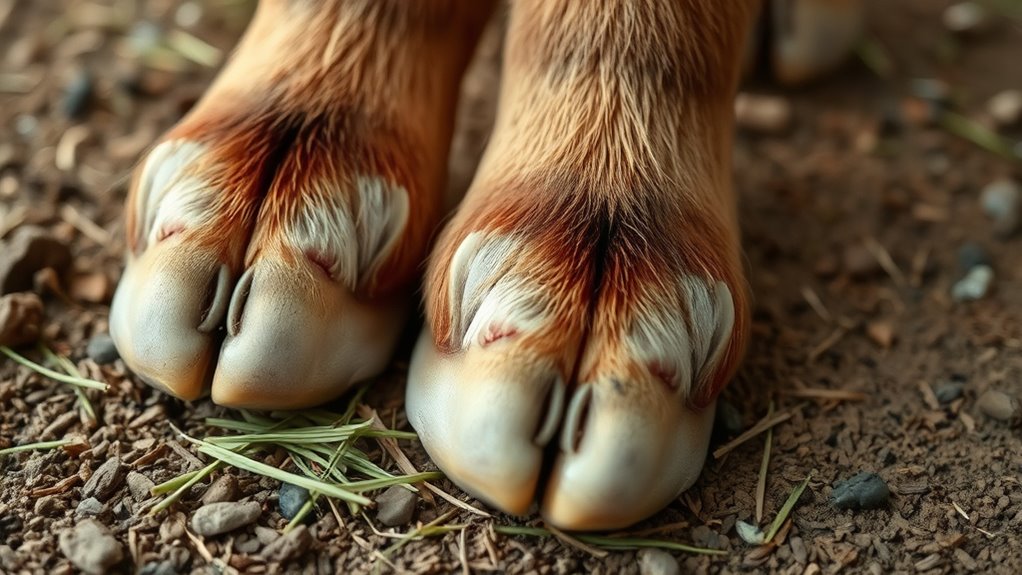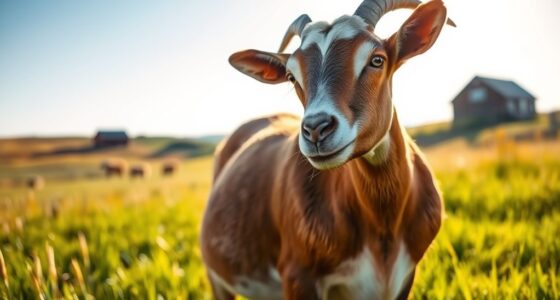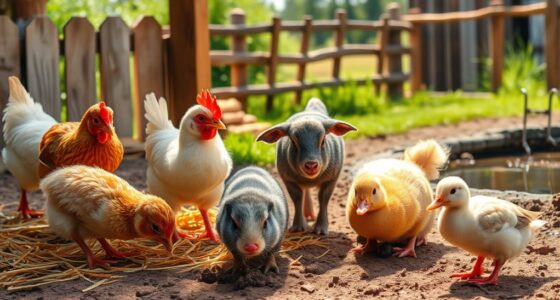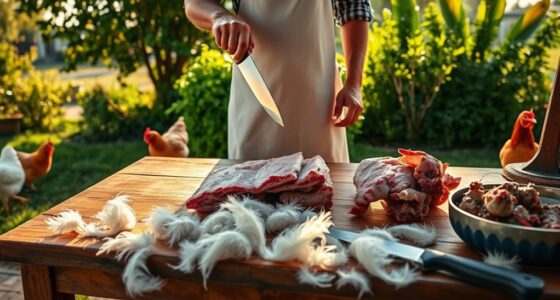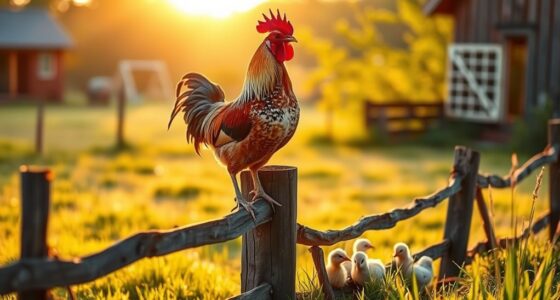To keep your goats healthy, focus on proper hoof care and disease prevention. Regularly trim hooves every 4 to 8 weeks with sharp, clean tools to prevent discomfort and infections. Maintain a dry, clean environment by removing manure and damp bedding, which helps prevent foot rot. Implement vaccinations, parasite control, and quarantine new or sick goats to reduce disease risks. Proper nutrition and breeding practices also support overall health. Continue exploring these tips to help your goats thrive.
Key Takeaways
- Regularly trim hooves every 4 to 8 weeks to prevent discomfort and infections.
- Maintain clean, dry living areas to reduce bacterial growth and foot rot risk.
- Provide a balanced diet with essential nutrients to support healthy hoof development.
- Implement parasite control and vaccinations to boost overall herd health and disease resistance.
- Quarantine new or sick goats and monitor hooves for foul odor, cracks, or swelling.

Are you aware of the essential health practices needed to keep your goats thriving? Proper hoof care and disease prevention are vital components of maintaining healthy goats, and understanding how to approach these areas can make a significant difference. To start, paying close attention to breeding considerations is crucial. Select healthy, disease-free goats for breeding, as this reduces the risk of transmitting illnesses and genetic issues. Proper breeding also involves timing and ensuring both goats are in good health before mating, which supports the overall health of the herd. Remember, a well-planned breeding program helps produce resilient offspring, less prone to disease and hoof problems.
Prioritize healthy, disease-free breeding to ensure resilient, hoof-healthy goats.
Nutritional management plays a central role in both breeding and hoof health. Your goats’ diet should be well-balanced, rich in essential nutrients like minerals, vitamins, and energy sources. Adequate nutrition supports strong hoof growth and helps prevent issues like foot rot or laminitis. Providing high-quality forage, supplemented with grains if needed, ensures your goats receive what they need to stay healthy and active. Proper nutrition also boosts their immune system, making them less susceptible to infections.
When it comes to hoof care, regular trimming is fundamental. Overgrown hooves can cause discomfort, alter gait, and lead to infections. You should check your goats’ hooves every 4 to 8 weeks, trimming only what’s necessary. Use sharp, clean tools to avoid causing injury or introducing bacteria. It’s also important to examine the hooves for signs of disease, such as foul odor, swelling, or cracks. If you notice any abnormalities, consult a veterinarian promptly. Good hygiene around the living area reduces the chances of hoof infections, as wet, muddy environments foster bacterial growth that can cause foot rot.
Disease prevention extends beyond hoof care. Vaccinations and parasite control are essential to keep your goats healthy. Regular deworming, based on fecal testing, prevents parasite overloads that weaken their immune system. Keep their living spaces clean and dry, removing manure and damp bedding frequently. Quarantining new or sick goats helps prevent disease spread within your herd. Moreover, ensuring your goats have access to clean water and good-quality feed supports overall health and resilience.
Frequently Asked Questions
How Often Should I Trim My Goat’S Hooves?
You should trim your goat’s hooves every 4 to 8 weeks to maintain good hoof health. Regular hoof trimming is essential for proper hoof maintenance and helps prevent issues like overgrowth and infections. Keep an eye on your goats’ hooves and trim them when they start to look overgrown or develop cracks. Consistent trimming keeps your goats comfortable and supports their overall well-being.
What Are Common Signs of Hoof Infections?
Think of your goat’s hooves as tiny, intricate factories—when infection symptoms show, it’s like machinery breaking down. Common signs of hoof infections include swelling, foul odors, lameness, and lesions. Pay close attention to hoof anatomy changes, like cracks or overly soft areas. Catch these issues early, and you keep the factory running smoothly. Recognizing these signs helps prevent more serious problems and keeps your goat healthy and happy.
Can Diet Affect Hoof Health?
Your goat’s diet substantially impacts hoof health because nutrition factors like proper vitamins and minerals strengthen hooves. Mineral deficiencies, especially biotin, zinc, and selenium, can cause weak or brittle hooves, making infections more likely. Ensuring a balanced diet with quality forage and supplements helps maintain strong, healthy hooves and prevents issues. Regularly reviewing your goat’s nutrition is essential for ideal hoof health and overall well-being.
How Do I Prevent Foot Rot?
Think of foot rot as a sneaky villain; you can outsmart it by maintaining good hoof health. Regularly hoof trim to keep the hoof structure balanced and prevent moist, muddy conditions where bacteria thrive. Keep your goats’ living area dry, clean, and well-drained. Routine inspections help catch issues early. By staying proactive with hoof trimming and proper sanitation, you’ll markedly reduce the risk of foot rot and promote healthier goats.
When Should I Seek Veterinary Help for Hoof Issues?
When you notice persistent hoof problems like swelling, lameness, or bad odor, it’s time to seek veterinary help. If you see hoof injuries that don’t heal or if hoof trimming reveals severe issues, don’t delay. Regularly inspect your goats’ hooves, keep them clean, and trim as needed. Prompt veterinary attention guarantees proper treatment, preventing complications and keeping your goats healthy and comfortable.
Conclusion
Taking good care of your goats’ hooves and staying vigilant for signs of disease is key to keeping them healthy. Regular hoof trimming and prompt attention to any issues can prevent bigger problems down the road. Remember, an ounce of prevention is worth a pound of cure, so stay proactive. By doing so, you’ll ensure your goats stay happy, healthy, and productive for years to come. Keep at it, and you’ll reap the rewards of a thriving herd.

